For many travelers, experiences in nature and in the wild are the pinnacle of exploration and swimming with whale sharks, the giants of the sea, is a dream experience with a worthwhile place on their bucket list (just like on mine). Lucky for us, Donsol whale shark interactions can easily become a reality in a way that protects the whale sharks, builds communities, and leaves us travelers with memories of the experience of a lifetime.
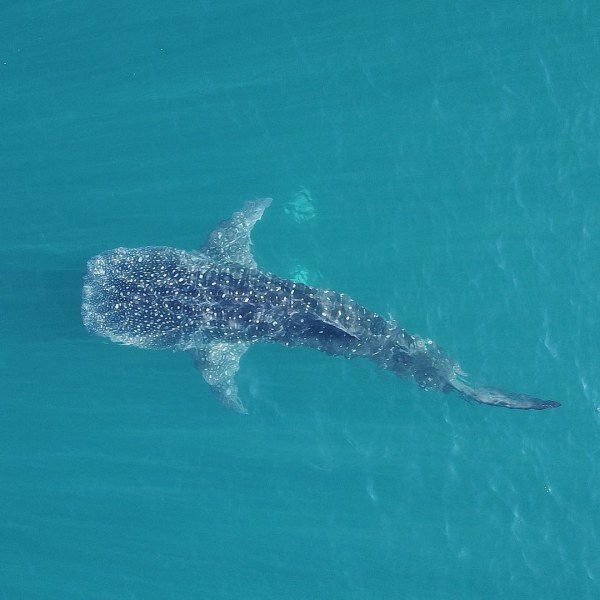
The Whale Shark: Giant of the Sea (Photo Credit: @whalesharksphilippines on Insta)
Read on for the most important things you need to know about swimming with whale sharks in Donsol, why it is one of the most eco-friendly options for the adventure, and how you can make it happen, easily, and cheaply
Table of Contents
- 19 Important things you need to know about the Donsol whale shark experience
- What to Expect on Your Donsol Whale Shark Experience
- The Rules of Interacting with Whale Sharks
- Whale Shark Stats and Facts
- The Story of Donsol: Fishing town to Eco-Tourism Mecca
- The World Wildlife Foundation’s involvement in Donsol Whale Shark Tourism
- The Debate of Donsol vs. Oslob: Which should you go to and why?
- Why you should go to Donsol
- How to Arrange a Tour for Swimming with Whale Sharks in Donsol
- How to Get to Donsol

19 Important things to know about the Donsol whale shark experience
- The rules of the “whale shark interaction” protect whale sharks and are important to keeping this adventure option alive. Because of this, be sure to know and follow the rules
- NEVER touch the whale sharks
- Maintain a distance of at least 3 meters
- Donsol is the most eco-friendly whale shark tourism option in the Philippines and one of the best in the world – a very natural, responsible way to experience the giants. Supporting ecotourism in Donsol encourages other sites (like Oslob) to follow suit and choose sustainable ecotourism practices
- Profits from whale shark tourism in Donsol go to whale shark conservation and community development
- Booking a whale shark experience in Donsol is much cheaper than online, but beware in high season as seats may fill up fast
- Virtually any time is good to experience whale sharks in Donsol, but December to May is best and ideally February to April offer the best chances of seeing and swimming with a whale shark in Donsol
- There is a chance, that you won’t see a whale shark, as whale shark interactions aren’t guaranteed
- Whale sharks aren’t dangerous – they’re docile “little” water puppies, as long as you keep your distance
- Get fins to improve your experience with the sharks! The sharks swim quickly when they want to move on, fins will help you keep up. Additionally, fins allow you to dive down, getting a great vantage point
- You can hire a marine biologist to join your tour and educate you throughout the experience with some tor providers. Be sure to ask if you’re interested
- Whale shark tourism in Donsol grew with cooperation from the World Wildlife Foundation offering advice and guidance for staying eco friendly
- Only snorkeling is allowed in Donsol on the main “whale shark experience circuit” – though there are dive sites where whale shark interactions may happen near Donsol
- Stats on the whale shark
- The maximum size of the whale shark is unknown, but could be as much as 20 meters (~60 feet), although, there have been unofficial reports of 30 meter (~90 feet) long whale sharks.
- Average length of mature whale sharks is 40 feet
- Average weight of mature whale sharks is 11 tons
- Whale sharks feed on the surface but adults may dive as deep as 1000 meters
- Average mature weight
- Feeding habits
- Population size
- The Whale sharks skin patterns are completely unique, like human fingerprints – no two patterns are alike
- Tourism in Donsol evolved from originally hunting whale sharks
- Whale sharks are currently an endangered species. Though protected in some countries, whale sharks are still a target of commercial fishing operations. Hundreds of whale sharks have been killed in China for fins, skins, and oil. Awareness and education are the best options for reducing the negative impacts humans have on the whale sharks. For this reason,even questionable operations (such as swimming with whale sharks in Oslob) stand to provide more benefit than harm to the whale sharks
- Whale shark tourism is contributing heavily to whale shark conservation and community development in the Philippines
- Taking a freediving course before swimming with the sharks will make the interaction much better. A basic freediving course will get you to the point of holding your breath for 2-3 minutes and diving to depths of 20 meters / ~60 feet without SCUBA gear. This will enable you to swim down, under, and around the shark, making the most of the experience. I did a freediving course before my whale shark experience and the ability to swim, dive, and stay underwater made the experience unreal.
- The Philippines was one of the first countries to adopt legislation protecting the whale shark, making it illegal to touch, fish, or harm the whale sharks in any way and punishable by fine or prison time
- “Interactions” with the whale shark are regulated by the Donsol Department of Transportation office and include limiting the number of people per boat, limiting the number of boats in the water, and requiring a minimum distance of 3 meters between swimmers and the shark
To swim with whale sharks or to not to swim with whale sharks: The choice is yours, but getting educated and spreading the word is best for the whale shark and the oceans.
Be sure to share some knowledge and facts with your posts when you put those shark selfies on insta (and don’t forget to tag @ABrotherAbroad so I can be there with you)
If you inspire someone else to swim with whale sharks, inspire them to do it the right way

What to Expect in your Donsol Whale Shark experience
After registering, with the visitor’s center or your tour provider you’ll be directed what time to arrive in the morning. Don’t forget your towel and a dry top to stay warm with the cool sea air blowing by after you get out of the water. Once everyone is accounted for, you’ll climb onto the boats and head out to see.
Boat types will vary, but expect one of the Filipino style outrigger boats, equipped with a salty crew. Once you all have loaded up you’ll be heading out to sea.

A traditional Filipino outrigger board gliding alongside a small whale shark (Photo Credit: @elysiabeachresort on Insta)
Some of the crew members will be dedicated to spotting whale sharks, just as these fellas are. As the boat cruises along and you enjoy the fresh air, they’ll keep their eyes out for dark spots in the water in areas where the sharks are known to surface and feed.

When a whale shark is spotted, you’ll be told to gear up and your captain will head straight for the whale sharks. The captain will aim to drop you just ahead of the shark, in the direction the whale sharks are swimming or up current.
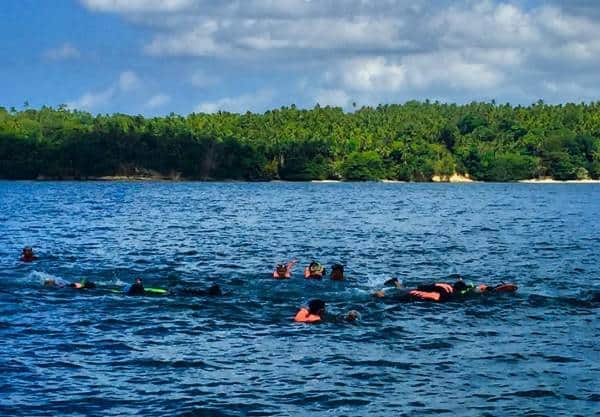
This way, the whale sharks will naturally swim right by you before diving giving you maximum interaction time with minimal swimming.
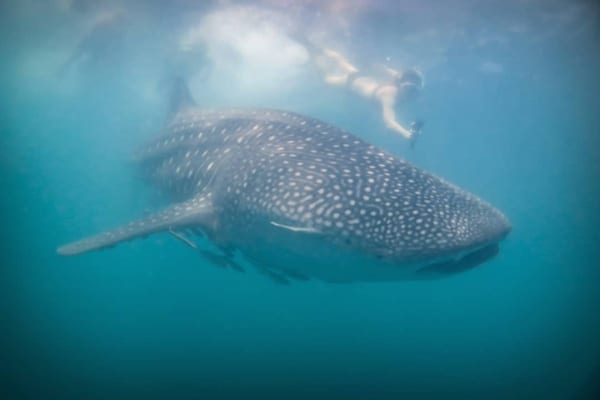
Once the sharks are gone, you’ll get back onboard and repeat for a few hours or until you and the crew are satisfied…whichever is shorter.
If you’ve booked a tour through an agency and are lucky enough a marine biologist may be on board to provide commentary. In all cases, this scientist will share information as it comes to mind and be open to answering any questions. Some of the biologists have been known to jump in with you as guides also allowing them to explain events or whale shark behavior (that you all may have observed) after getting out of the water. The Buntanging Interaction Officer (BIO) may also jump in the water too, with the goal of observing and enforcing rules.
Do keep in mind that the second one boat finds a whale shark, all other boats will be following after shortly, so don’t expect to have the shark to yourself forever.
Do keep in mind that a whale shark interaction is not guraranteed.

The Rules of Interacting with Whale Sharks
- Stay at least 3 meters from the whale shark
- Do not touch the whale shark
- Do not wear sunscreens or bug repellants in the water
- No SCUBA diving or motorized vehicles (SCUBA scooters, jet skis) used in the interaction
- Stay 5 meters from the whale sharks tail
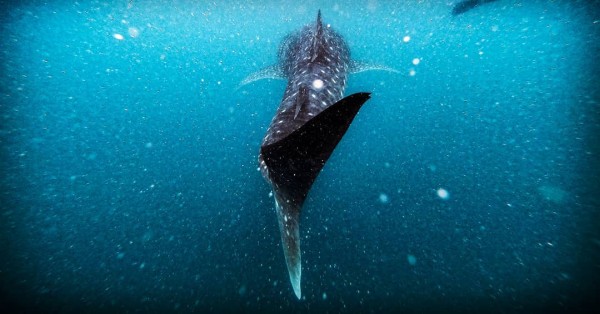

Whale Shark Stats & Facts
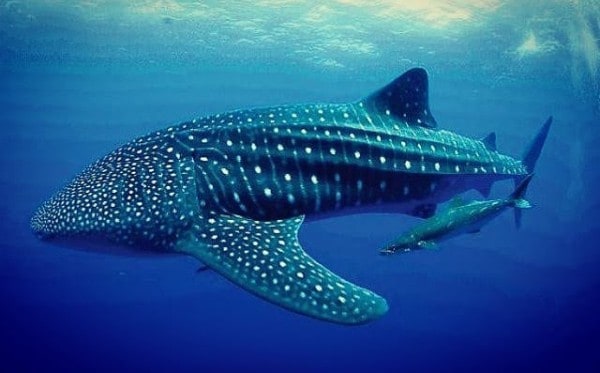
- Max recorded Length: 18 meters / ~55 feet
- Unofficial Max Observed Length: 30 Meters / ~90 feet
- Average Weight: 11 tons
- Max Dive Depth: Up to 1000 Meters for adults
- Diet: Zooplankton (microorganisms)
- Pupping (birth) has never been observed and pups are also rarely observed
- Max length: unknown
- Average lifespan: unknown
Whale sharks are very mysterious because of two factors. First, most of their lives are spent at depth, beyond where humans can follow easily. Second, these creatures are nomadic, known to travel thousands of miles follow food, natural patterns of life, and other unknown factors.
The point is, we as people just can’t keep up with whale sharks…which is why they remain a mystery

The Story of Donsol: How this fishing town became an eco-tourism mecca
Once upon a time, Donsol was simply a poor fishing village, lackluster and with most its residents living near the poverty level. During that time, and as early as 100 years ago, whale sharks were viewed as an opportunity to fish and a jackpot payday. Weighing in at nearly 11 tons on average, a single whale shark could bring years’ worth of income for a poor fisherman.

In 1998, with the ratification of the “Philippines Fisheries Code of 1998” it became illegal to hunt, catch, or harvest whale sharks (and manta rays), dead or alive. With this change, the fishermen had to adjust their habits to survive.
Around the same time, a group of SCUBA divers swam and interacted with a Donsol whale shark, getting footage of the experience. The video showed that whale sharks were docile by nature and that the experience of swimming with them was safe, very achievable, and immensely enjoyable. The former whale shark fishermen, who once used spotters to locate whale sharks to hunt, now used their skill of hunting whale sharks to locate them and facilitate eco-tourism interactions.
The world wildlife foundation caught wind of the activities and offered their support and mentorship in developing the Donsol whale shark tourism into the sustainable, eco-friendly operation it is today.
The Donsol whale shark operation has contributed much to finance development, social programs, and investment in marine conversation and protective activities for endangered whale sharks and manta rays as well as other marine life near Donsol.

The World Wildlife Foundation’s involvement in Donsol Whale Shark Tourism
Since the first organized and publicized whale shark interactions ~1998 and the passing of Philippine laws protecting whale sharks in 1998, the World Wildlife Foundation has actively supported the Donsol eco-tourism operation. Their goal has been
The Debate of Donsol vs. Oslob: Which should you go to and why?
Though you can swim with whale sharks in Oslob for far cheaper, Donsol’s tourism operation is unquestionably positive, leaving little doubt the operation results in a “net positive” outcome.
Dosnol’s guide teams and Buntanging Interaction Officers (BIOs) ensure that a limited number of boats are in the water, with a limited number of swimmers, and that all swimmers stay at least 3 meters from the shark – any violations will result in fines or prison time.
Though Oslob’s tourism activities are growing it has yet to fully enforce limits for the number of boats in the water and the number of swimmers allowed for each interaction. The interaction area, a ~20 meter circle, can be crowded with countless boats and flailing swimmers, make the experience less than enjoyable for some. Also, plan on being very early (4:00AM) if you have any hope of beating the crowds in Oslob
Oslob whale shark interaction site: notoriously crowded with tens of boats and thousands of snorkelers during high season (Photo Credit: @Odeagal on Insta)
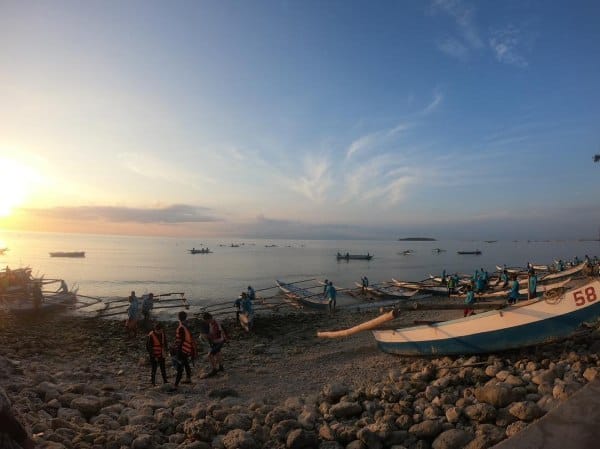
Outside of regulation and enforcement, the main reason to go to Donsol over Cebu is that it is completely natural. Whereas in Oslob, Cebu, sharks are baited into warm, shallow waters, where they rarely spend time naturally instead staying in the cooler waters further out to sea. The Donsol team merely follows the sharks, avoiding any actual interaction, and facilitates observing them in the water. This approach results in no change to the habits of whale sharks (e.g., where they eat, where they live, how they interact with boats) which is the primary criticism of the Oslob operation and the argued benefit of the Donsol operation.
If you can afford the extra money, head to Donsol to encourage truly sustainable tourism that doesn’t disrupt the whale shark’s way of life. The mayor of Oslob has spoken of increasing the price of the interaction to limit the number of participants so hopefully the tourism industry in Oslob will continue following in Donsol’s positive footsteps.
If Donsol is out of your budget, I still recommend going to Oslo but please read “Why I DID Swim with Whale Sharks in Oslob” get a perspective on the full picture in Oslob.

Why do the whale sharks come to Donsol? Rich Food Sources and Great Underwater Topography
Whale sharks feed on zooplankton which are tiny microorganisms in the water. These little creatures prefer nutrient rich waters to provide their food as well. The Donsol River, which dumps into Donsol’s bay, delivers the nutrients which attract the plankton which ultimately attracts the whale sharks.

Additionally, the underwater topography and depth is welcoming to the whale sharks, providing the deep, cool waters they call home in close distance to lush feeding areas rich with plankton.

How to arrange a tour for swimming with whale sharks
The cheapest way to swim with the whale sharks in Donsol is to register at the Donsol visitor center in Barangay Dancalan. It is best to do this in advance, especially during the busy season as the number of boats and spaces on them are limited. If you decide to simply register the day of, just show up at the visitor center at 7:30AM.
You will pay a registration fee of 300 PHP (~$6 USD) as a foreigner and a 3500 PHP (~$70 USD) split between a boat of maximum 6 people. Each boat will be assigned a Buntanding Interaction Officer to guide the interaction with the whale sharks.
Alternatively, you can have your hotel or guesthouse book the interaction for you, for a small fee, or go to one of the dive or tourism shops, like Frontier Whale Shark Tours, for a more tailored experience. These private guided tours usually include a marine biologist that enters the water with you and adds an element of education to the experience.
A Movie of Some Travelers’ Experiences in Donsol…Just for the Mood…

How to get to Donsol
By Plane: Fly into Legazpi, there are several flights daily from Manila and three from Cebu City
By Bus: From Manila, 13 hours direct to Donsol or several to Legazpi including overnight options
Getting from Legazpi to Donsol: 1.5 Hours by public bus from the bus terminal or private van from the airport. Private vans cost between 1500 PHP and 2500 PHP ($15 – $25 USD). Jeepneys from Legazpi to Donsol are 65 PHP ($1.30 USD) but much slower
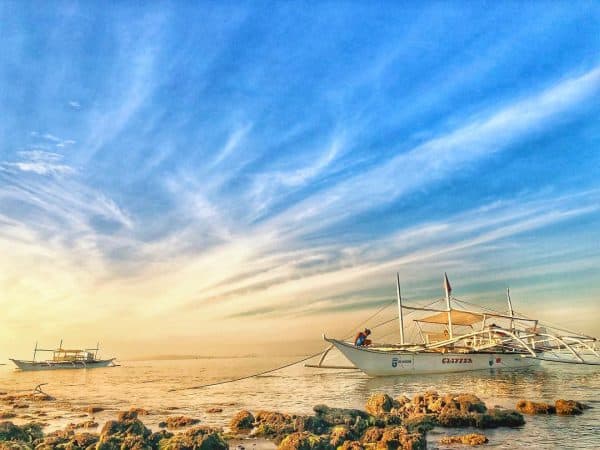

Other Interesting Reads from on Whale Sharks in the Philippines:
- Donsol Hosts Most Whale Sharks on Record: http://wwf.panda.org/?206218/donsol-hosts-most-whale-sharks-in-philippines-reveals-wwf
- Whale Shark Tourism Fuels Small Economies in the Philippines: http://wwf.panda.org/wwf_news/?23534/Whale-shark-ecotourism-contributes-to-Filipino-economy
A Note on the Photograpy:
ABA is taking an opportunity to go social and share the work of other creators. Many of the images to be featured over the coming months are shared from social media accounts. I’ve run into tons of aspiring photographers, creators, and small businesses. I’ve decided to hunt them out and share their images in my content to increase reach. If you like what you see, support their work with a follow (all accounts linked in photo credits).
Sources:
- https://www.abc.net.au/news/2014-02-05/an-hundreds-of-sharks-killed-annually-in-illegal-trade-in-china/5239568
- https://www.worldwildlife.org/species/whale-shark
- http://www.environment.gov.au/node/15908#states


ABOUT THE AUTHOR
Carlos is a nomad, slow traveler, and writer dedicated to helping others live abroad and travel better by using his 7+ years of experience living abroad and background as a management consultant and financial advisor to help other nomad and expats plot better paths for an international lifestyle. Click here to learn more about Carlos's story.
